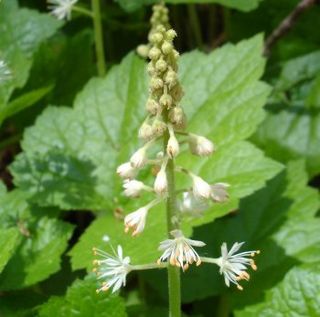
The Rutaceae is a family, commonly known as the rue or citrus family, of flowering plants, usually placed in the order Sapindales.

Melicope is a genus of about 240 species of shrubs and trees in the family Rutaceae, occurring from the Hawaiian Islands across the Pacific Ocean to tropical Asia, Australia and New Zealand. Plants in the genus Melicope have simple or trifoliate leaves arranged in opposite pairs, flowers arranged in panicles, with four sepals, four petals and four or eight stamens and fruit composed of up to four follicles.

Saxifragaceae is a family of herbaceous perennial flowering plants, within the core eudicot order Saxifragales. The taxonomy of the family has been greatly revised and the scope much reduced in the era of molecular phylogenetic analysis. The family is divided into ten clades, with about 640 known species in about 35 accepted genera. About half of these consist of a single species, but about 400 of the species are in the type genus Saxifraga. The family is predominantly distributed in the northern hemisphere, but also in the Andes in South America.

Murraya is a genus of flowering plants in the citrus family, Rutaceae. It is distributed in Asia, Australia, and the Pacific Islands. The center of diversity is in southern China and Southeast Asia. When broadly circumscribed, the genus has about 17 species. A narrower circumscription contains only eight species, others being placed in Bergera and Merrillia.

Esenbeckia is a genus of flowering plants in the rue family, Rutaceae. All species in the genus are native to the Americas, with the highest diversity in South America. They are commonly known as jopoy, the Mayan word for E. berlandieri, or gasparillo (Spanish).
Limnocitrus is a genus of plant in the family Rutaceae with one species, Limnocitrus littoralis. It is native to Vietnam and Indonesia, where it is found on the island of Java in Jepara. In traditional Vietnamese medicine different parts of the plant have been used as an expectorant, antitussive product, for exudation, and the treatment of colds and fevers.
Merrillia is a monotypic genus of flowering plants in the citrus family, Rutaceae, containing the single species Merrillia caloxylon. Its English language common names include flowering merrillia, katinga, and Malay lemon. In Malaysia it is called ketenggah and kemuning gajah. The species is native to Malaysia, Thailand, and Sumatra in Indonesia.
Platydesma is a formerly recognized genus of plants in family Rutaceae. Evidence from 2009 indicated that Platydesma is nested within the genus Melicope and is sister to all Hawaiian Melicope species, and it is now placed within that genus. The other Melicope species are dioecious, whereas the flowers of species formerly placed in Platydesma are hermaphroditic, suggesting a rare evolutionary reversion away from dioecy. Species included:

Pleiospermium is a genus of plant in family Rutaceae.
Spathelia is a genus in the plant family Rutaceae, subfamily Cneoroideae. Species records are from central America and the Caribbean.

Aurantioideae is the subfamily within the rue and citrus family (Rutaceae) that contains the citrus. The subfamily's center of diversity is in the monsoon region of eastern Australasia, extending west through South Asia into Africa, and eastwards into Polynesia.

Zanthoxylum asiaticum is a species of plant in the family Rutaceae. Under its synonym Toddalia asiatica, it was the only species in the monotypic genus Toddalia, now included in Zanthoxylum. It is known by the English name orange climber.
Clymenia is a small genus of flowering plants in the family Rutaceae with two species. The genus is often included in Citrus.
Toddalioideae is a formerly recognized subfamily of the family Rutaceae. Its type genus, Toddalia, is now accepted as a synonym of Zanthoxylum and placed in the subfamily Zanthoxyloideae.

Cneoroideae is a subfamily of flowering plants that belongs to the family Rutaceae. The subfamilies Dictyolomatoideae and Spathelioideae are now included in the subfamily Cneoroideae.

Atalantia is a genus of flowering plants in the citrus family, the Rutaceae.
Neoschmidia is a genus of shrubs in the family Rutaceae. The genus is endemic to New Caledonia in the Pacific and contains two species.

Harrisonia is a small genus of flowering plants in the subfamily Cneoroideae of the Rutaceae. Older taxonomic treatments have placed this genus in the Simaroubaceae.

Zanthoxyloideae is a subfamily of the family Rutaceae.
Amyridoideae is a subfamily of the family Rutaceae. The circumscription of the family has varied considerably. A 2014 classification placed a large proportion of the genera in the family Rutaceae in Amyridoideae. A more recent 2021 classification includes only three genera.













